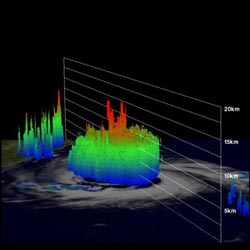NASA's infrared image of major Hurricane Adrian reveals its stormy life's blood

This 3-D image of Major Hurricane Adrian was created from data on June 9 and show thunderstorms dropping rain at a rate of over 50 mm/hr (~2 inches) in a nearly circular eye wall. The PR also indicated that some thunderstorms in the eye wall were shooting up to heights above 15 km (~9.3 miles). Credit: Credit: NASA/SSAI: Hal Pierce<br>
NASA's Aqua satellite flew over Hurricane Adrian this morning at 8:29 UTC (1:59 a.m. EDT), and the Atmospheric Infrared Sounder instrument took an infrared snapshot of the storm's many strong thunderstorms and warm ocean water below.
The infrared data suggests that Adrian has an eye, as in the center of circulation on the infrared image is a blue-colored U-shape. Because AIRS imagery is false-colored, purple represents the highest, coldest cloud tops and strongest thunderstorms, and blue represents lower, warmer cloud tops. The coldest cloud top temperatures are as cold as or colder than -63 Fahrenheit (-52 Celsius). The blue area in the center of the larger area of purple in the imagery suggests that some overcast clouds are obscuring an eye. Other satellite data has confirmed the eye.
The Tropical Rainfall Measuring Mission (TRMM) satellite captured rainfall and cloud data from Hurricane Adrian when it passed directly above on June 9, 2011 at 0714 UTC (3:14 a.m. EDT). The increasingly powerful hurricane had sustained winds estimated to be close to 80 kts (~92 mph) at the time of this pass. TRMM's Precipitation Radar (PR) instrument revealed that beneath the clouds there were intense thunderstorms dropping rain at a rate of over 50 mm/hr (~2 inches) in a nearly circular eye wall. The PR also indicated that some thunderstorms in the eye wall were shooting up to heights above 15 km (~9.3 miles).
At 11 a.m. EDT (8 a.m. PDT), Hurricane Adrian had maximum sustained winds near 115 mph, making it a category three on the Saffir-Simpson scale and the season's first major hurricane as well as the first hurricane in the eastern Pacific. Hurricane force winds extend out from the center by up to 30 miles (45 km) and tropical storm force winds extend outward up to 80 miles (130 km).
Adrian was about 440 miles (710 km) south-southeast of Cabo Corrientes, Mexico near 14.2 North and 104.1 West. It was moving west-northwest near 9 mph (15 kmh) with a minimum central pressure of 960 millibars.
Hurricane Adrian's strength and proximity to land means that Southwestern Mexico's coastline will continue to get large swells and rip currents through the early part of the weekend. Adrian is expected to enter cooler waters by the early weekend which will sap some of his strength. The National Hurricane Center forecasts Adrian to continue moving out to sea and away from land.
Media Contact
More Information:
http://www.nasa.govAll latest news from the category: Earth Sciences
Earth Sciences (also referred to as Geosciences), which deals with basic issues surrounding our planet, plays a vital role in the area of energy and raw materials supply.
Earth Sciences comprises subjects such as geology, geography, geological informatics, paleontology, mineralogy, petrography, crystallography, geophysics, geodesy, glaciology, cartography, photogrammetry, meteorology and seismology, early-warning systems, earthquake research and polar research.
Newest articles

Bringing bio-inspired robots to life
Nebraska researcher Eric Markvicka gets NSF CAREER Award to pursue manufacture of novel materials for soft robotics and stretchable electronics. Engineers are increasingly eager to develop robots that mimic the…

Bella moths use poison to attract mates
Scientists are closer to finding out how. Pyrrolizidine alkaloids are as bitter and toxic as they are hard to pronounce. They’re produced by several different types of plants and are…

AI tool creates ‘synthetic’ images of cells
…for enhanced microscopy analysis. Observing individual cells through microscopes can reveal a range of important cell biological phenomena that frequently play a role in human diseases, but the process of…





















